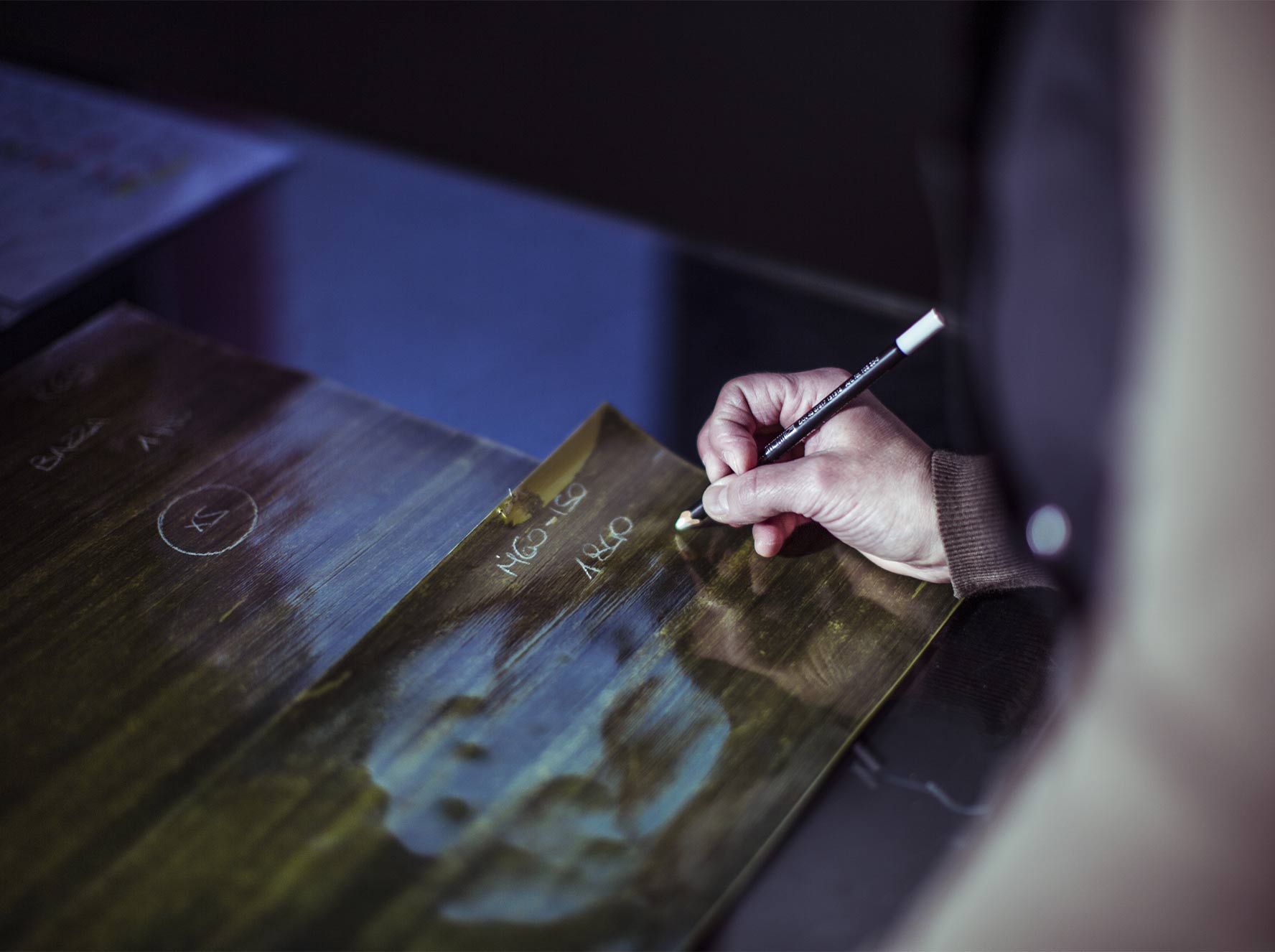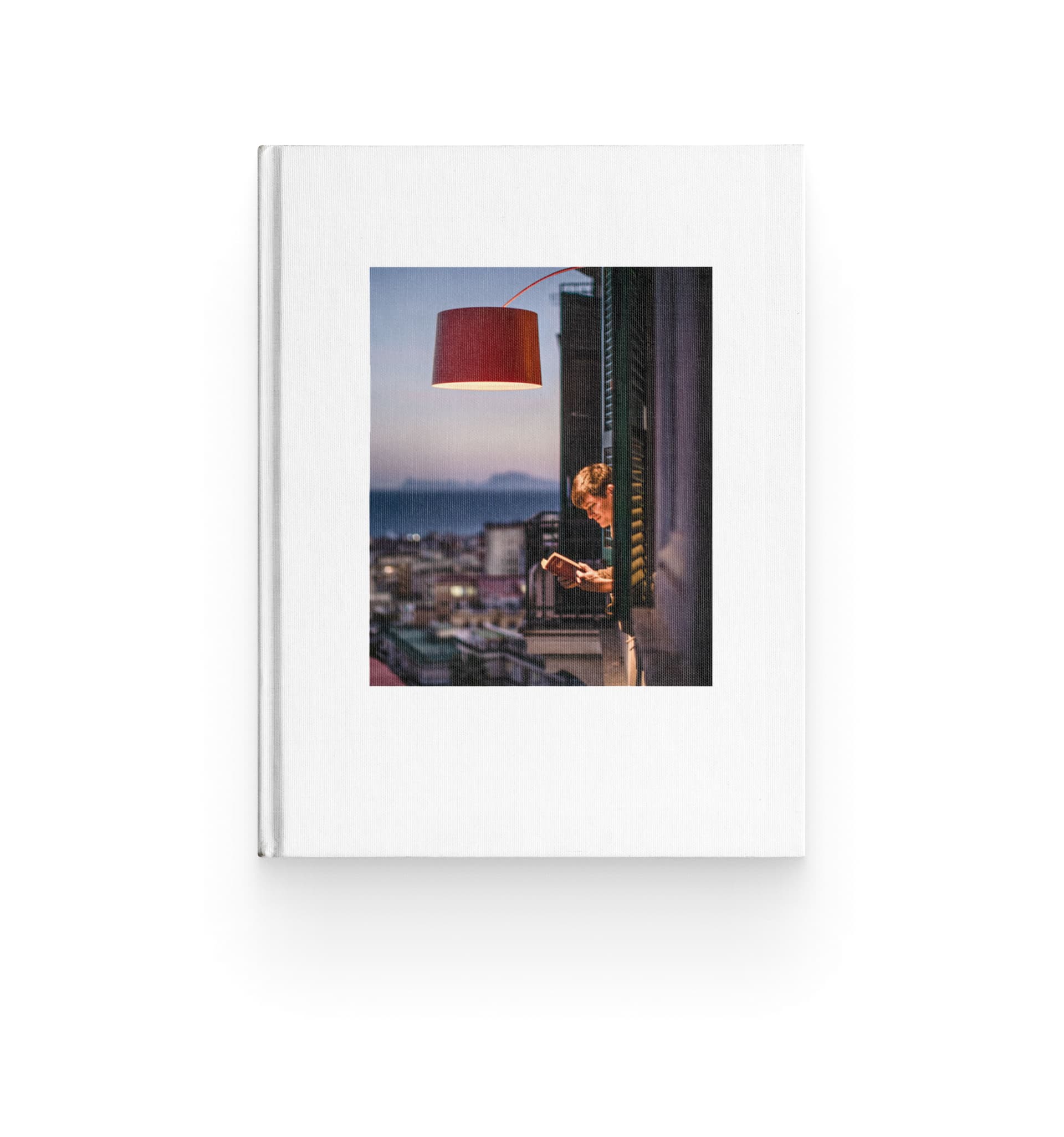Making Design
by: Stefano Micelli
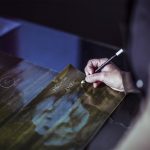
The birth of a lamp
To understand how the Mite lamp happened, I met with Marc Sadler at the headquarters of FAPS, the company based in Fiume Veneto, in the province of Pordenone, where the lamp took form and is still produced today. The design and development of Mite date back to the late 1990s. The project took its cue from the potential of innovative materials like fiberglass and carbon. Sadler had already made a prototype: a floor stand with an auto headlight at the top. It was just an idea that needed to be developed with someone who knew these materials and how to transform them.
We began our conversation in the small meeting room near the company entrance, but soon we were roaming to have a look at some of the phases of workmanship that still go into the lamp today. We were joined by Maurizio Onofri, owner of FAPS, and Giorgio Valeri, who has collaborated on all of Sadler’s experiments over the years. Observing the machinery customised by the FAPS technicians, watching the work of the operators, who like dressmakers spread the fibre of Mite before the passage in the autoclave, seeing the phases of the finishing of the product, were all moments that contributed to enhance our understanding of its design.
To understand FAPS we need to backtrack a bit, at this point. FAPS is a company that was already focusing on composite materials at the end of the 1980s, an absolute novelty at the time. After having fully thought out the use of these innovations, the firm decided to invest in the production of fishing rods for sportsmen: poles with a length of about 15 metres, of remarkable strength and lightness. The production of fishing rods, together with other subcontracted items in carbon fibre, represented the fundamental activity of this start-up for years. At the end of the 1990s the opportunity arose to also use composite materials in the field of furnishings. The potential of fiberglass and carbon fibre was no longer restricted to particular kinds of technical performance, but could also be applied to different situations, last but not least to the development of an innovative image. This was how the collaboration with Foscarini and Marc Sadler began.
Strolling past the machines and craftsmen of FAPS, Sadler told us about the discussions and the passion with which the entrepreneur got involved in three years of difficult but exciting experimentation. It would be hard to imagine a multinational with the typically obsessive controls putting up with such a costly and complex experimental path. Sadler himself admits that major “unreasonable leaps” are needed to discover the potentialities of materials and technologies. Saturdays spent on thinking about alternative prototypes, evenings devoted to exploring uncharted paths. To achieve success passion and obstinacy are both musts. Furthermore, it is important that the company – Foscarini in this case – be capable of setting the economic and temporal boundaries, to make sure the effort is aimed at a product for the market, not just an amusement for hobbyists.
After three years of striving, experimenting with materials and prototypes that gradually converged in the final product, the Mite lamp was born, and won the Compasso d’Oro in 2001. Marc Sadler has always spoken of the importance of the work conducted at FAPS, and he has always acknowledged the merits of the collaborators who contributed so much to the form and quality of his project. Theirs is a fundamental role, often unfamiliar to the general public and sadly underestimated in most design chronicles.
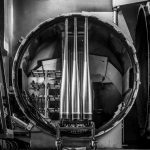
The return of a protagonist
The tale of the Mite lamp is far from unique in the history of Italian design. The development of new products by successful designers has always been able to rely, in our country, on a surprising supply of expertise connected with the making of prototypes. The existence of many small companies and craftsmen has made it possible to pass quickly from a design idea to a three-dimensional manufactured object. This is also true in the world of lighting, which has made use of traditional materials like glass as well as innovative substances like composites. For years the contribution of this know-how has been an essential factor in the growth of Italian design, but without ever translating into a narrative capable of recognizing and identifying the protagonists who have contributed to the evolution of the entire sector.
Today our task is to think about the groundwork for a new narrative, for a range of different reasons. Behind this new history of Italian design lies the need to explain and take stock of the value of the objects that are offered to an increasingly attentive and well-informed international market. If today we are thinking about the work of artisans behind the production of lamps like Mite (and other products created in similar circumstances) it is because the potential buyer who approaches a high-quality product wants to be able to recognise the signs of a material culture and know-how that contribute to shape objects charged with meaning and historical perspective. The expertise of the craftsman that enhances and completes the work of the designer is a qualifying factor for Italian products on international markets. In a world where ideas and intuitions of all kinds spread faster and faster, in which hackathons and elevator pitches abound, it is urgent to emphasise the role of companies like FAPS in that are able to nurture the insights and ideas of designers.
The construction of the prototype is an exercise that is not limited to the definition of the quality of the final product. What is proven by the story of Mite, like other similar creations, is that the contribution of these craftsmen also includes assessment of technical and economic feasibility with respect to the production process. What reaches the market is not just something coherent and functional. It is also a product that conforms to economic parameters thanks to processes and techniques of manufacturing that are sustainable in terms of materials and labour. Those who take part in giving form to the project are the same people who will oversee its production, in small or large quantities. The focus on the dimension of manufacturing feasibility is what leads to the economic sustainability of the producer.
It follows that the third success factor of a product is the commitment and care the client puts into project development. The designer/prototypist dyad finds support and constraint in the client. The ability to nurture an idea and make it become a product requires a commitment that cannot be underestimated. The role of the entrepreneur/producer is crucial to accompany the designer-developer dialectic in all its phases. Innovative products demand an exercise of development and definition that is the result of the encounter between disparate perspectives and forms of knowledge. The company that brings a given product to the market has the job of constantly updating the commitment of the parties, keeping the requirements of the demand side, the channels of distribution and the role of the media in mind.
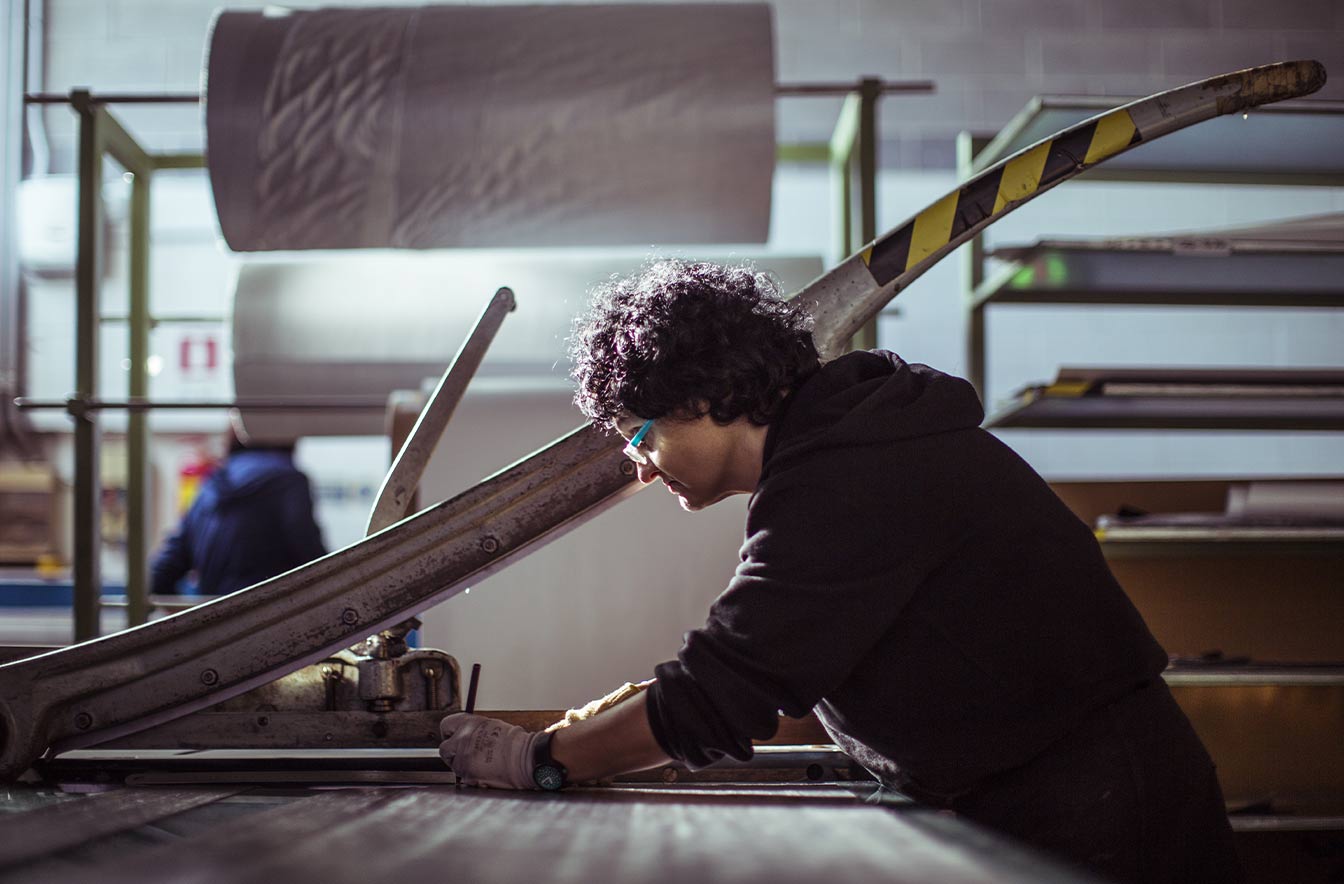
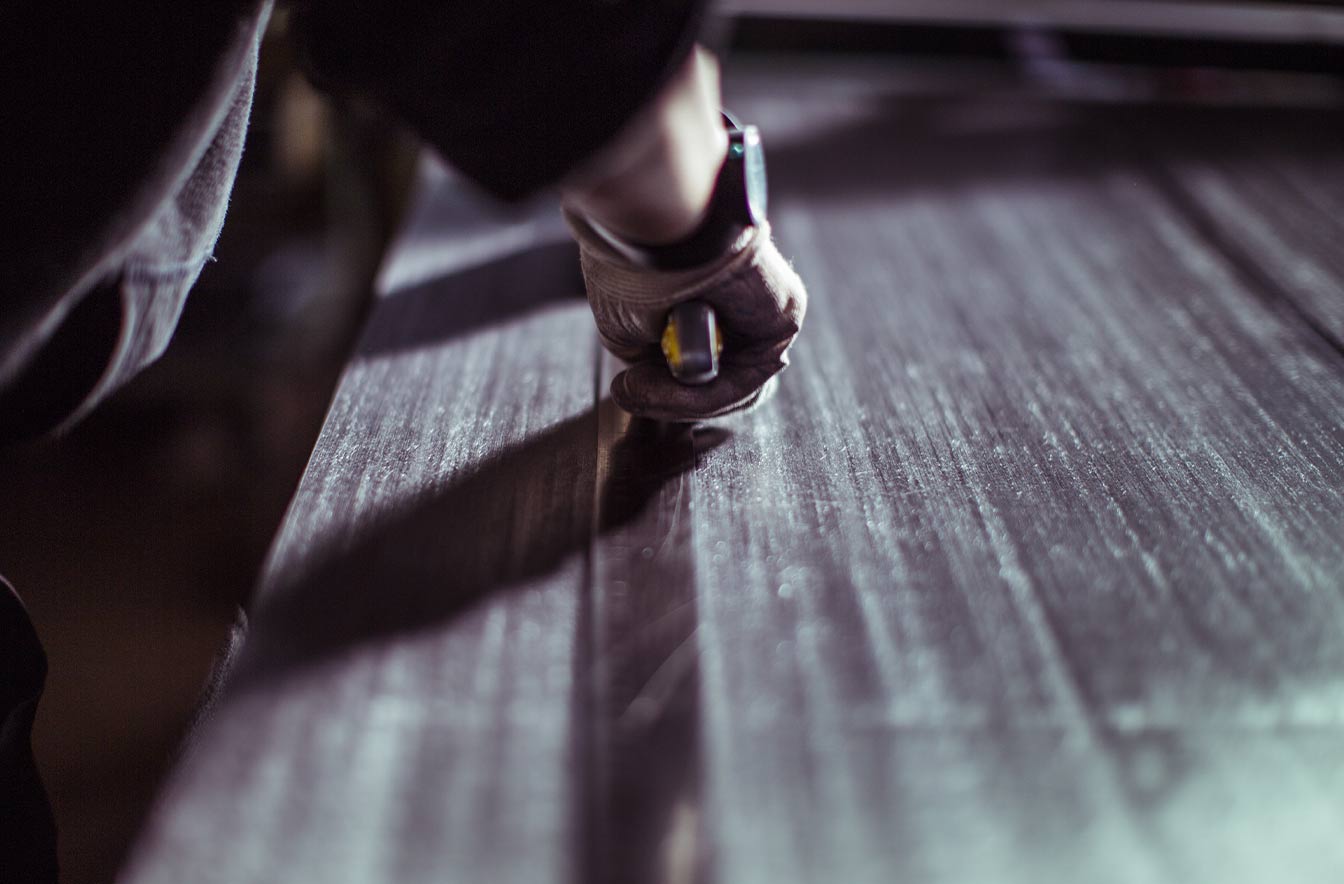
The curtain rises
To bring out the value of a project like Mite and, more generally, of much of the output of companies like Foscarini, we need to get beyond the entrepreneur-designer duo and call into play the artisanal know-how that is the foundation of the success of so many of the high-quality furnishings of Made in Italy. Obviously this does not imply any lack of respect for the many businessmen and designers who have written the history of Italian furniture. The idea is instead to expand the narrative formulated to date, to insert a component that has long been overlooked. The time has come to acknowledge a factor capable of determining a prolific creativity that is otherwise hard to explain, a factor that has made it possible to achieve economic objectives that would be very hard to pursue in the order of traditional industry.
For a company like Foscarini, recognising and bringing value to the role of its suppliers in the phase of product development and production are important steps. For many years, people thought that it was possible build a corporate reputation without calling the dimension of making into play. For years we have thought of the brand, which sums up the values and aspirations of the company, as a true curtain: the world of production was hidden from the gaze of the final consumer, because it was considered too disorderly, complex and problematic to be put on stage, hopefully in front of an international demand-side audience.
But times have changed. Those who purchase a design object today want to understand why one product costs more than another, the reasons that justify the value. They are no longer convinced by generic promises of quality repeated on the advertising pages of glossy magazines. They want to know more. They want to learn about the effective quality of a given product and a given production process. They want to understand the values and culture that have made a particular object possible, the people and places that have gone into its creation.
This does not mean that the brand is an obsolete concept. Quite the opposite. But what does seem to be irremediably obsolete today is the way many companies have constructed an image for themselves without any reference to the efforts and commitment of all kinds of backstage protagonists. In the world of furnishings, the possibility of narrating and emphasising the passion, dedication and know-how that have made a product like Mite possible now seems like a constituent element of the project and the product as a whole. The curtain rises. The story comes alive. There is a new tale to tell, many tales, in fact. Because every product Foscarini has put on the market has gone through phases of doubt, trial and error, wrong turns, things that are worth bringing to public attention because they are part of a background of experiences that tells the story of a company. And they lie at the origin of the care and passion that go into its products.
Craftsmanship and modernity
Rodolfo Dordoni was the art director of Foscarini from 1988 to 1993. A short time in which to chart a unified course for the production of the company as a whole, but long enough to personally create a number of projects that have set the path of the Venetian company. Those were years in which some of the protagonists of lighting had already formulated original strategies, approaching the industry with strong, innovative choices. Companies like Vistosi and Barovier&Toso had already developed their own design signatures. This kind of signature was still lacking in Foscarini’s output. What was needed was a product that would set the direction of the company’s efforts, while sending a clear signal to the market. The Lumière lamp developed by Rodolfo Dordoni became the manifesto of the Foscarini aesthetic, writing an important page of its corporate history.
The Lumière project began in 1990, in collaboration with a company – Vetrofond – that had recently left Murano to settle on the mainland near Venice. Linked to the tradition of blown glass, Foscarini wanted to assert its contemporary character by developing a project that would combine the typical poetics of blown glass with technology more in tune with the times. The idea took form in a quick sketch: a sort of cap in blown glass, supported by a base in die-cast aluminium. The timing between the intuition and the product development was also quick. The result mixed two dimensions: the craftsmanship of the Venetian tradition and industrial workmanship of aluminium. The pendulum – Dordoni recalls – swung in the direction of an image more closely connected to the use of new materials. Foscarini proposed a dialectic between distinct worlds, suggesting an original balance that was to become the characteristic feature of a long-term project.
After 20 years the lamp was the focus of restyling done by Dordoni himself. This was an opportunity to develop a series of innovative solutions, some of which were for only a particular market niche. The colourings were updated, a variation of reflecting glass was introduced, while the proportions were altered, also in XXS-XXL variants. The idea was not to design another lamp, but to approach the same object with a different accent. The pendulum swung in the opposite direction from that of the initial design, moving towards greater emphasis on craftsmanship, and recognition of the manufacturing quality Vetrofond is capable of providing.
The reasons behind this new emphasis lie in a period of sweeping change in demand-side sensibilities. With respect to the past, people who approach a lighting object are looking for a product that can honestly convey a sense of its specificity, its cultural matrix. This does not necessarily imply objects made completely by hand, as Dordoni himself emphasises. “Consumers want manufacturing that is capable of conveying an emotion, often connected with details that can be traced back to production involving craftsmanship.” It is a question of honesty, of stating how the craftsmanship effectively contributes to the creation of a given product, and of how this dimension becomes comprehensible to the educated gaze.
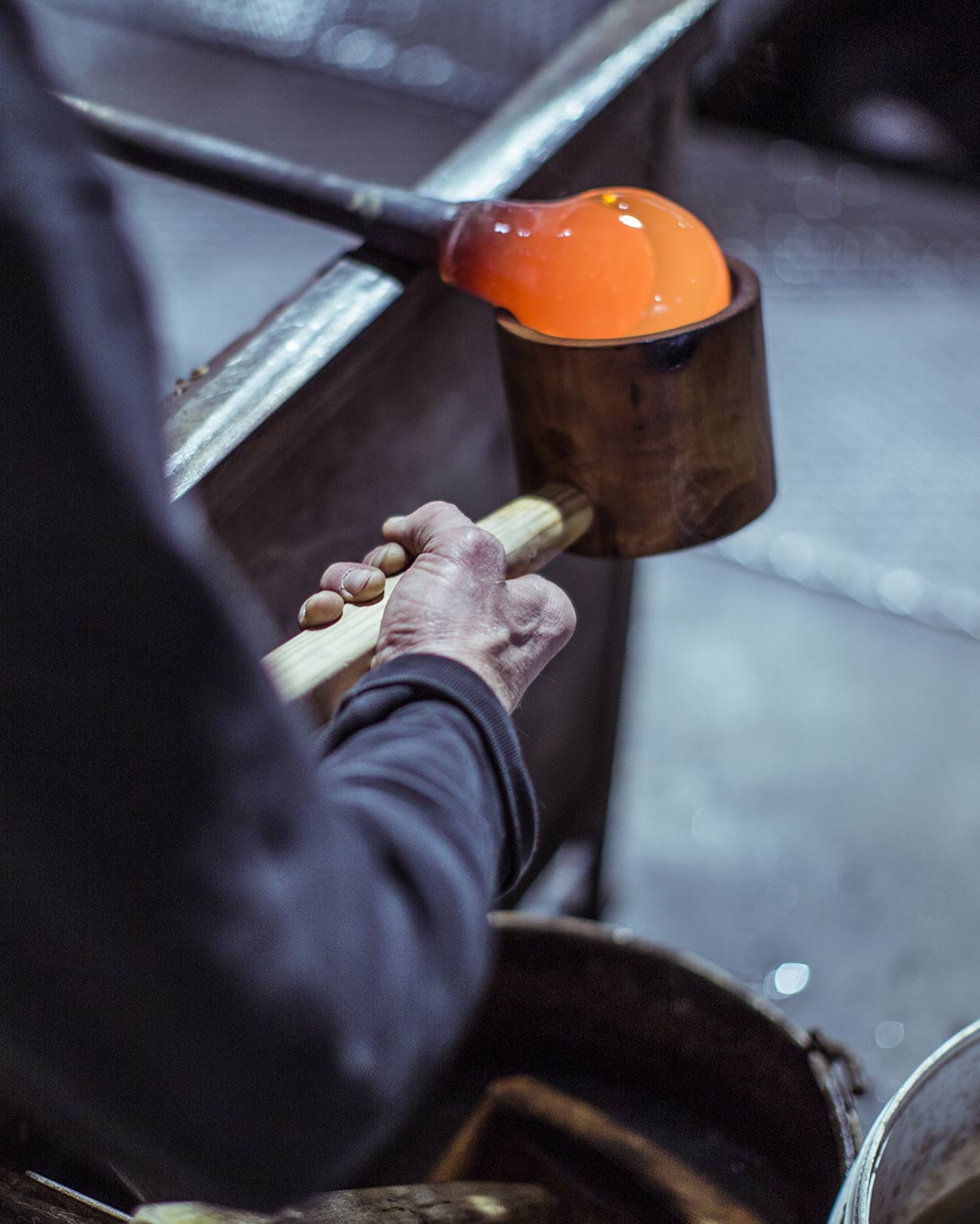
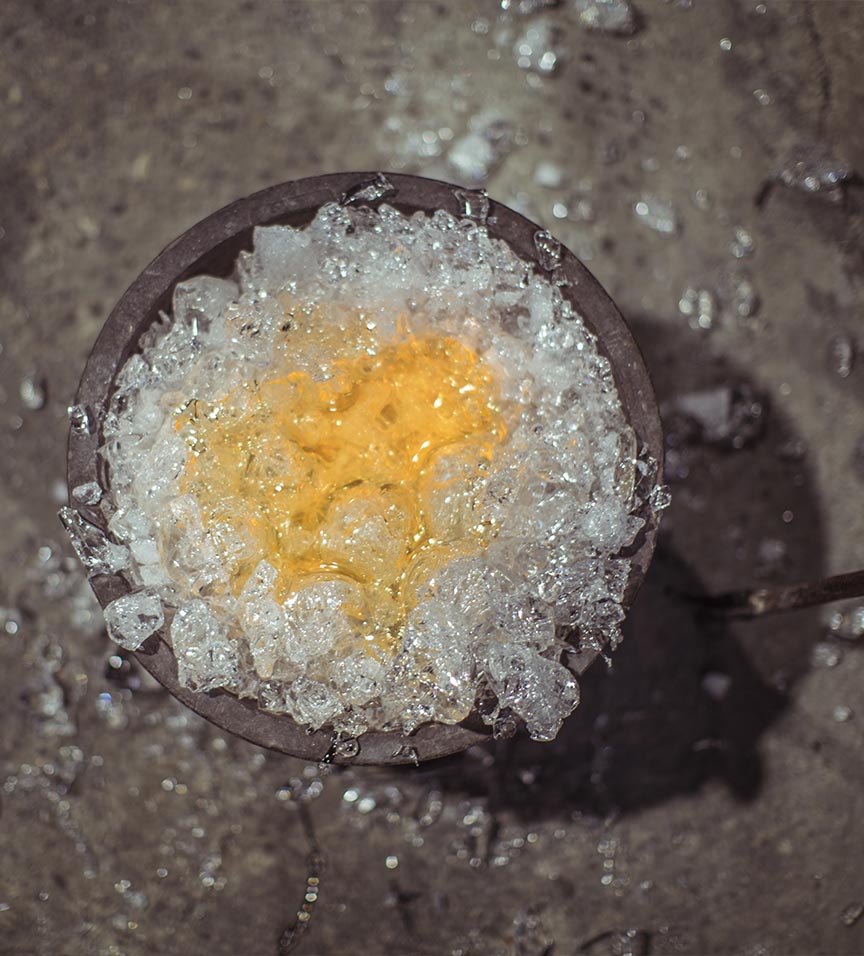
A changing idea of quality
A different idea of quality. This is the terrain of an important challenge for Italian design, on which Italy has to develop a specific idea of value. For many years Italian companies have looked to German manufacturers as the reference point for an idea of quality seen as rigorous compliance with technical standards. For many Italian manufacturers, however, those standards have now been achieved and can be taken for granted. At the furniture fair in Cologne products Made in Italy needn’t have any inferiority complex. The issue is that Italian companies now have to express something more. They have to promote objects of superior quality that are capable of conveying an emotion, communicating the cultural value of know-how, igniting empathy with lifestyles and social models.
How can we get beyond the idea of quality seen as standardisation, to promote a project of quality seen as a trigger of new social and cultural relationships? The debate is far from new. Some of these themes are part of the reflections proposed over a century ago by the Arts and Craft movement at the end of the 1800s, reflections that crossed the entire 20th century in a more or less visible way. John Ruskin and William Morris always imagined that the idea of quality would not be limited to compliance with mere parameters of execution, but would also have to do with bringing out the value of the subjectivity of the maker, with the possibility of creating a living, intense connection to the sensibility and culture of the producer of a given artefact. The apprentice sculptor at work on the construction site of a Gothic cathedral, with his touch in the finishing of a gargoyle, left a personal trail of his commitment to a major collective project. When we look at those cathedrals we can again see a people in motion, a set of lives taking part in an effort that goes beyond the value of individuals while at the same time it contains them and respects them. Likewise, Italian manufacturing ought to bear witness to the flair and ability of making: a lamp, a wardrobe, a kitchen. The entire chain has to be able to absorb and convey the signs of this expressive ability, bringing them to the market in understandable form. The designer, in particular, has the task of leaving a margin of expressive quality without letting it threaten the overall framework of the production of an object of high quality.
This demand for quality has become a distinctive aspect of products in other fields as well. In the world of fashion and luxury, the appeal of craftsmanship represents a tool to justify often daunting prices. Major luxury brands have learned how to communicate the specific forms of expertise that lie behind their production. In this way, they have stimulated new interest in artisanal work, and they have contributed to reconsideration of its economic and social role. In many cases this effort has gone beyond the proprietary confines of the individual company, supporting schools, exhibitions, foundations that have helped to revive an idea of quality closely linked to the cultivated gestures of human beings. If many fashion and luxury houses can now position their products in a particularly challenging price range, it is because in recent years the bond between style, design and know-how has gained greater visibility.
The democratic tradition of Italian design has made this strategy harder to implement. The contribution of craftsmanship does not therefore serve to justify higher quality, but to bear witness to the capacity of Italian manufacturing to respond needs of variety and personalisation. The idea is to mix – without faking it – the results of a process of standardisation of an industrial character with what stands out as the contribution of an individual.
In this sense the evolution of design has to stay in step with the transformation of the small and medium businesses that represent its supply system. Their evolution has to blend managerial rationality with clearly recognizable aspects of craftsmanship. These companies have to be able to develop a digital culture in tune with the times while perpetuating human gestures in an economically sustainable way. The more the project requires the inclusion of parts that can only be made by expert hands, the more the businesses presently involved in the chain of design production will be forced to rethink their productive capabilities. The issue is to promote automation and digital rationalisation while at the same time reinforcing the experience and manual skill of classic artisans. It is probable that refined and organised craftsmanship can effectively help us to gain acclaim in the world. It can become a distinctive feature of designing and formulating a different kind of manufacturing. It is our strong point, but perhaps it is also our limit.
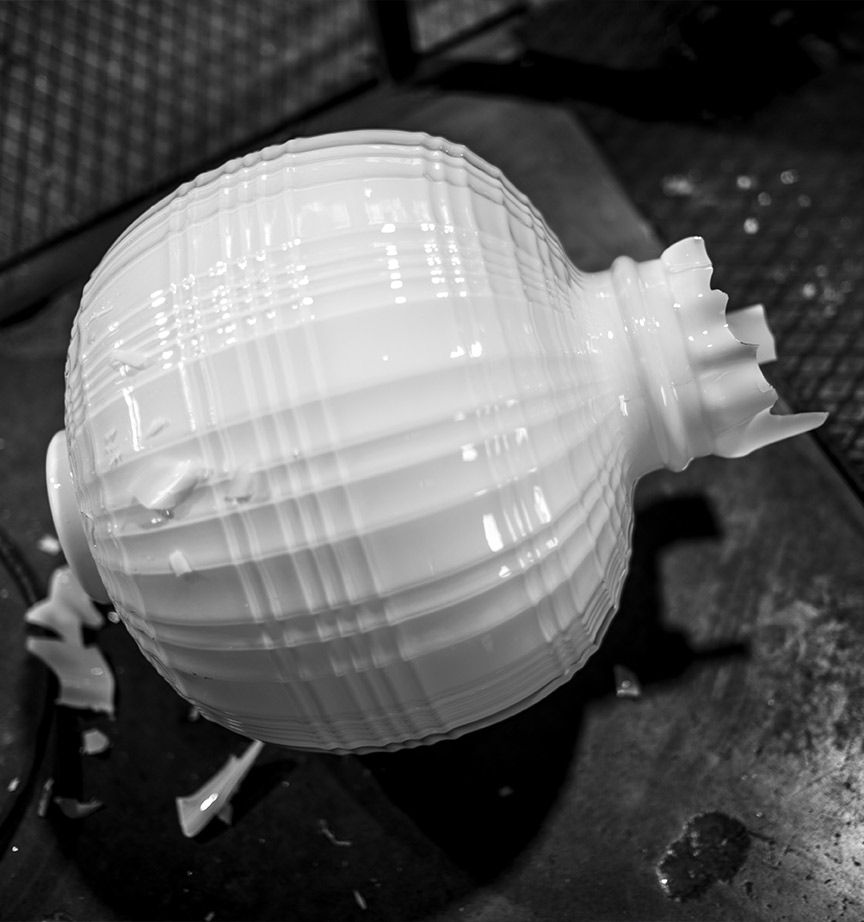
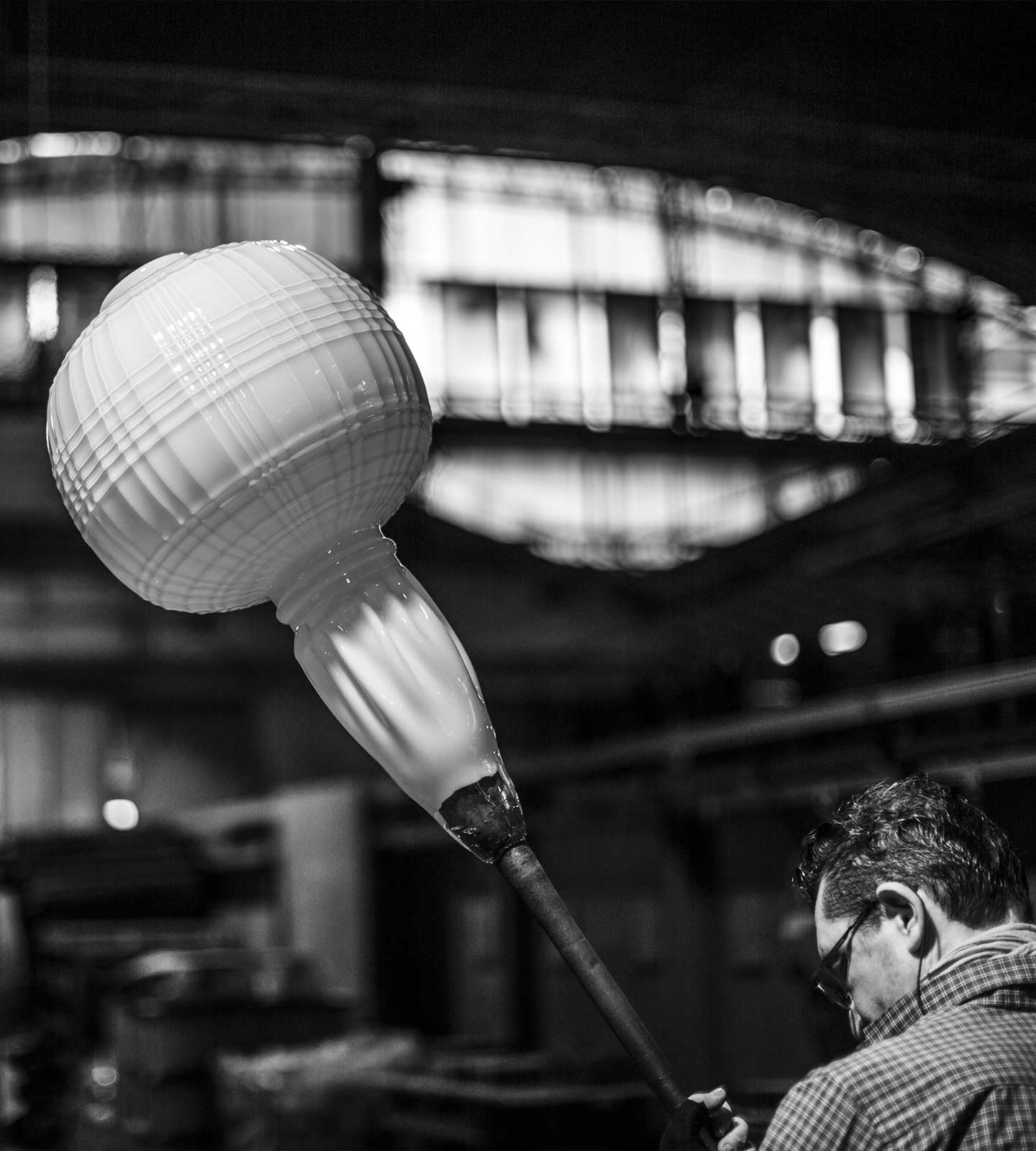
The aesthetics of diversity
“When we began the project that led to the Rituals lamps, we were thinking above all about a sensation.” When Roberto Palomba tells the story of one of Foscarini’s most successful lamps, he traces back through an effort of imagination that was transformed, after two years of work, into a particularly sophisticated glass object. The aim of the project was to create a lamp that would generate a living light, ready to accompany life in the home and acting as an antidote to the worries of life. A vibrant light that could only be supplied by the use of glass.
The path leading to the development of the prototype was not an easy one. The initial intuition met with encouragement due to the experience of Giancarlo Moretti, founder and still chairman of Vetrofond. The grinding of the glass had to let the light filter through, ensuring the kind of light envisioned in the initial hypothesis. The choice of colour – white – also represented a challenge at the level of prototyping and industrial production. The mould and the subsequent work phases had to be in line with a market price that would make the lamp affordable for a vast range of possible consumers. The final product, the Ritual lamp that has been in the Foscarini catalogue since 2013, is the result of dialogue and interaction between designers who shared a focus on the quality of the project.
What is striking about Giancarlo Moretti is his ability to blend craftsmanship with business organisation, artisanal know-how with limitation of costs. The glassworks at Casale sul Sile is a magical place where master glassmakers and their assistants operate amidst furnaces and workbenches in what seems like a never-ending dance. One wonders how so many people can work in such a limited space without interfering with each other. This movement of men and pipes, surprising even for those who know about life in a glassworks, is anything but disorderly. Each position is filled by an artisan specializing in certain types of workmanship, to bring out the talents of each individual. Unexpected technological experiments happen from time to time, helping the workers to avoid repetitive activity without particular gratification.
Giancarlo Moretti can boast of two outstanding capabilities. He knows that the expertise accumulated by Vetrofond is a guarantee for those who want to develop innovative products. “If they come to Vetrofond with 100 drawings of new products in one year, we will be able to develop 98 of them. At other glassworks it would be hard to reach 20.” The experience gathered in fifty years of on-going work with leading Italian design companies has made Moretti a favourite counterpart for the most demanding designers. Vetrofond’s contribution does not only involve product development. The efforts of recent years to improve the company’s entire organisation make it an example of economic rationalism to limit costs and guarantee prompt delivery. The know-how of Vetrofond is organised and structured to make the firm competitive with other forms of workmanship of a more strictly industrial character. The continuous drive to improve and the focus on optimizing margins at this glassworks are truly impressive. Thanks to these efforts in terms of organisation and technology, today it is possible to create magical products at affordable prices. A lesson that should bring a sense of pride to the entire design production chain.
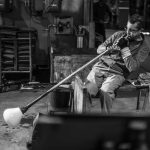
The pleasure of experimentation
“It cannot be done.” The Aplomb lamp ran into some problems at the start. And the message “it cannot be done” can still be seen on a drawing Lucidi & Pevere sent to Crea, the small company in Darfo where Aplomb lamps are now constantly produced today. “It cannot be done” was what Giovanni Piccinelli wrote to his sons Carlo and Ottavio after having seen the thicknesses suggested by the design duo from Palmanova for the first concrete lamp offered on the market with these technical specifications. Two centimetres was just too thin for traditional workmanship. It was hard to make a suitable mould, just as it would be hard to find a material that could respond to the challenge set out in the design. Crea comes from the world of construction, where the orders of magnitude are different, where weights are much greater, and the forms call for much larger geometric shapes. How could they come to grips with something so small, so thin?
Giovanni Piccinelli has always been a curious craftsman. An inventor. Someone who discovers things. Like many of the great Italian artisans, he has never lost his taste for trial and error, experimentation. He has always had a passion for playing with new mixtures, new materials. Making moulds is an ability Piccinelli has developed through his own initiative, his own stubborn effort. First with the help of a specialist, then as an autodidact, often spending weekends on attempts to invent something new. Paolo Lucidi and Luca Pevere understood him: working with entrepreneurs like Piccinelli is a pleasure, and the only problem is to find a pretext to have fun finding original solutions. The most outlandish technical challenges are the best excuse to discuss things and to test one’s reasoning.
The possibility of finding counterparts of this type is essential for young designers: artisans who are aware, a priori, that the production runs will be small. They do not expect to amortise the costs of the initial experimentation through major economies of scale. Instead, they know that what has been learned in the project phase will get utilised in new, different initiatives, perhaps with other companies. What there is to be learned from a difficult project can be capitalised in the next project. The lesson absorbed from a certain type of product can become material for something else, something different, perhaps for products associated with other sectors.
This is just what happened. From the first moulds of the Aplomb to the present, Crea has radically changed its way of operating on the market. A company that once focused on construction has become a leader over time in the use of concrete in the field of design. The craftsman who constructed houses and buildings now comes to terms with moulds for lamps, tables, pen holders. A radical change of direction that reflects the firm’s ability to solve problems in an innovative way, putting experimental research to work on any challenge suggested by a client. After Foscarini, many other design companies have taken advantage of the inventive prowess of Crea. Over the years these experimental artisans have demonstrated that they can make a real contribution to the production chain of the most sophisticated design, thanks to know-how developed with a material like concrete that was long considered too hard to handle, too challenging for most projects in the world of furnishings.
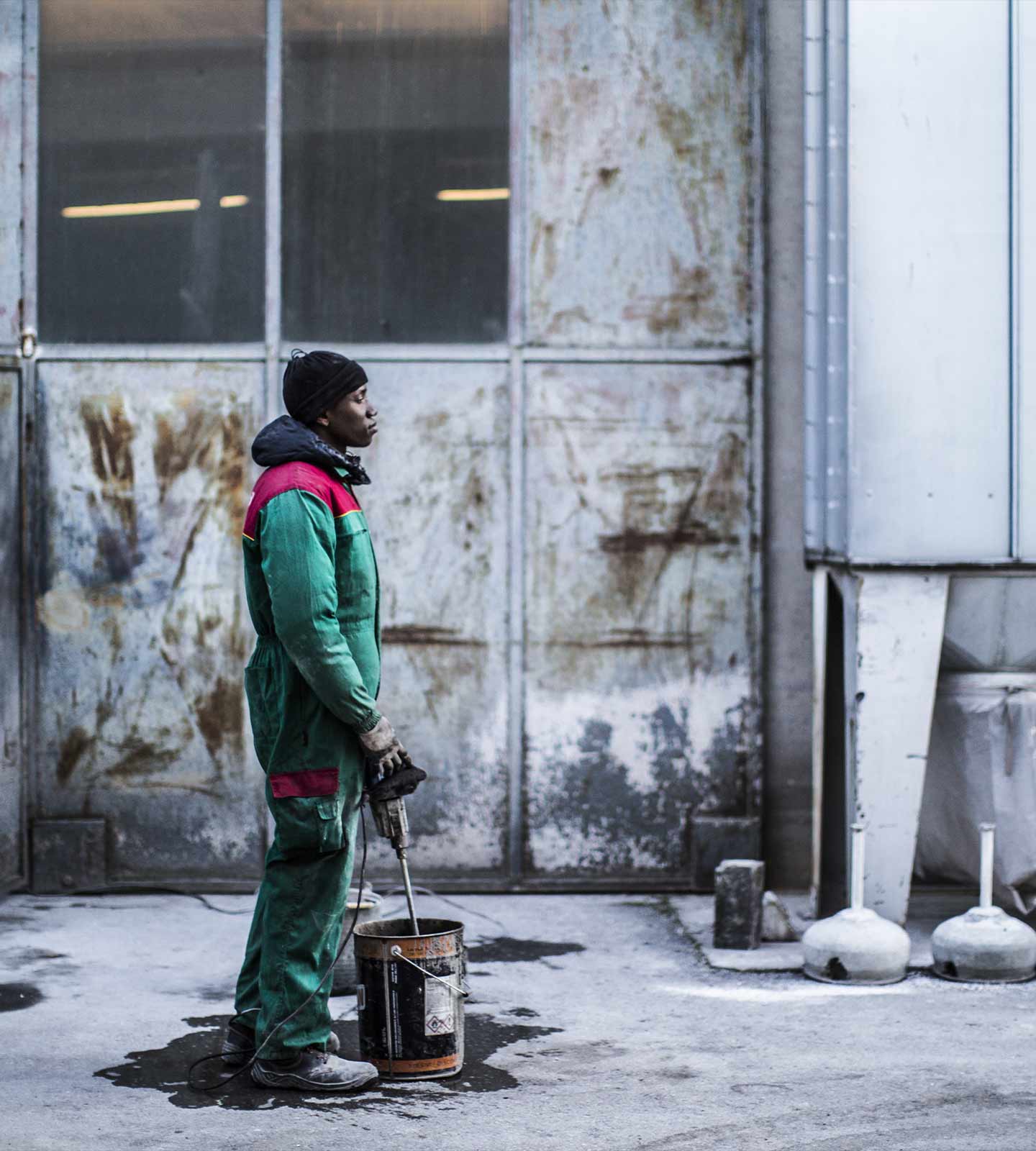
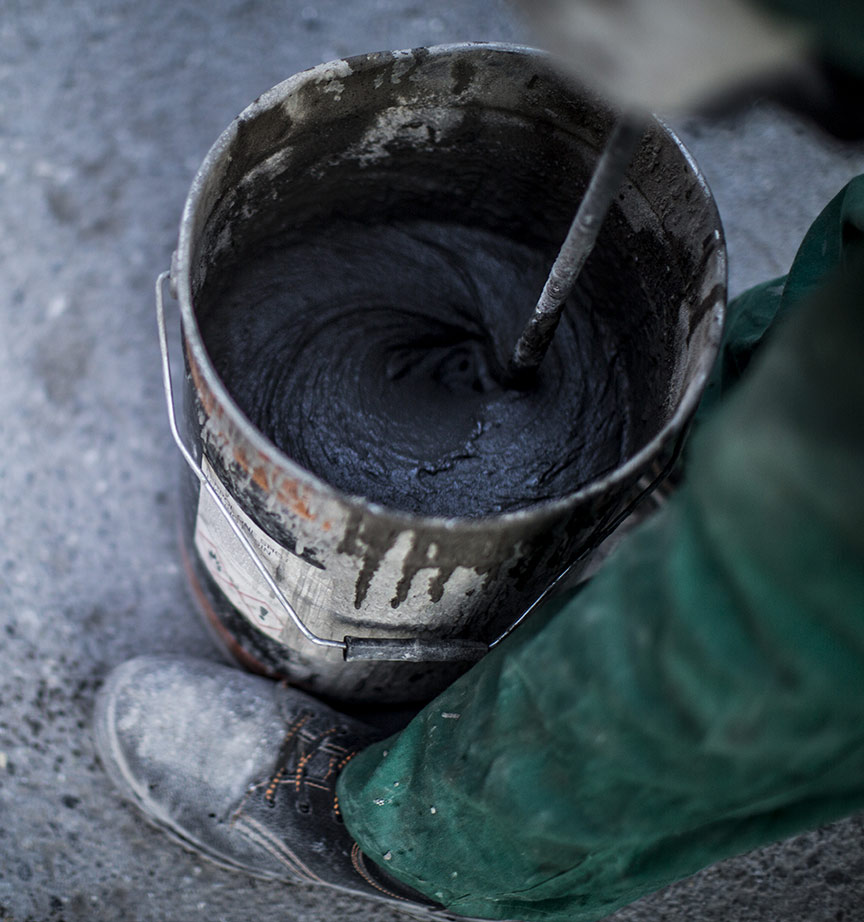
A project that includes
The Italian design companies we have learned to refer to as “editors”, or makers of editions, have often had to tolerate the fact of not being able to have and control their own production processes. Those who have applied an organisational model based on independent designers and quality suppliers have often avoided boasting about it, in spite of their awareness of the strong points of this type of structure. The reasons behind this modesty lie in a historical legacy that sees vertical integration of businesses, capable of covering production and sales, research+development and distribution, as the true reference point for the corporation.
In recent years, however, the debate in economics has helped to bring out a different viewpoint. The idea of business networking has gained ground, definitively pushing aside the myth of the factory capable of combining all productive activities inside its boundaries. Many entrepreneurs have become aware of the importance of outsourcing specific manufacturing activities, precisely because they respect paths of specialisation and expertise that could not be replicated within the confines of a single business. Today the idea of open innovation brings another radical step forward for this postulate: we are aware that the world is full of good ideas, perhaps developed by young independent talents, and forms of expertise that deserve to be called into play. It is the entrepreneur, together with his staff, who has to grasp the value of these forms of knowledge and these innovators, translating these abilities – still in an embryonic state, in some cases – into market value.
The narrative in which Foscarini wants to be a leading figure today takes this direction into account, and attempts to take another step forward. The company has always been open to the talent of the most outstanding designers, while taking advantage of the knowledge and capacity of businesses that have been able to safeguard and update specific skills in the manufacturing field. The objective is to acknowledge the value that has been created by the firm’s most prestigious designers and to bear witness to the role and importance of the skills that go into the high quality and aesthetic value of the company’s products. Above all where this dense network of quality suppliers is concerned, Foscarini’s tribute sets out to celebrate social and cultural values. The interplay of relationships and efforts that gives rise to such ambitious projects deserves to be illustrated and thus widely understood and appreciated. All of the people involved should be given credit where credit is due.
The reasons behind this accent on acknowledging the work of those who share in these experiences have to do with a new idea of economic value. Those who purchase a design object, be it a Mite lamp or a Tress, just to stick with the Foscarini catalogue, do not simply need an object capable of shedding light. They are not seeking a generic technical solution to a problem. Those who approach objects of this type are looking for new social and cultural connections – and sophisticated, original products are the medium. The objects that have led to the fame of Made in Italy in the world respond to this type of need: they are connectors capable of triggering relations between different sensibilities, different cultures. The more this increasingly international and interconnected demand becomes strong and urgent, the more companies will have to learn to narrate their own work and their own world. They will have to state their position. The objects they produce will have to bear witness, in the world, to the substance and value of this cultural proposal, of these social and territorial bonds.
In this perspective, Foscarini’s commitment becomes part of a path that has lasted 50 years. The Italian design of the 1960s triggered a challenge to the uniformity of mass production, bringing colour and variety to the logic of industrial manufacturing. The imagination and creativity of human beings finally returned to the centre of production processes that were otherwise ruled only by technical rationales. At the start of the fourth industrial revolution Italian design is ready to renew its “humanism” by again challenging the idea of production as a merely technological pursuit. The goal, in this case, is to reflect on and rethink the value of the objects that accompany our everyday existence. Objects that are less like goods and more like intermediaries, to connect cosmopolitan demand to a world of values and people that renew the ideals of quality and beauty through their work.
Stefano Micelli
Stefano Micelli is professor of e-business at the Department of Management of Ca’ Foscari University in Venice. For twenty years he has conducted continuous research on the issue of the spread of new technologies in small and medium-sized companies and Italian industrial districts. In the field of digital and manufacturing research, he has conducted several projects in collaboration with Banca IFIS and Make-in-Italy Foundation, and has also developed, for three Italian editions of the “Maker Faire” an ad hoc section linked to the theme of digital and new manufacturing. He has written many articles and books, including the volume “Futuro Artigiano, L’innovazione nelle mani degli italiani”, winner of the Compasso d’Oro ADI award, on the theme of positive contamination between craftsmanship and the global economy.
Further details
